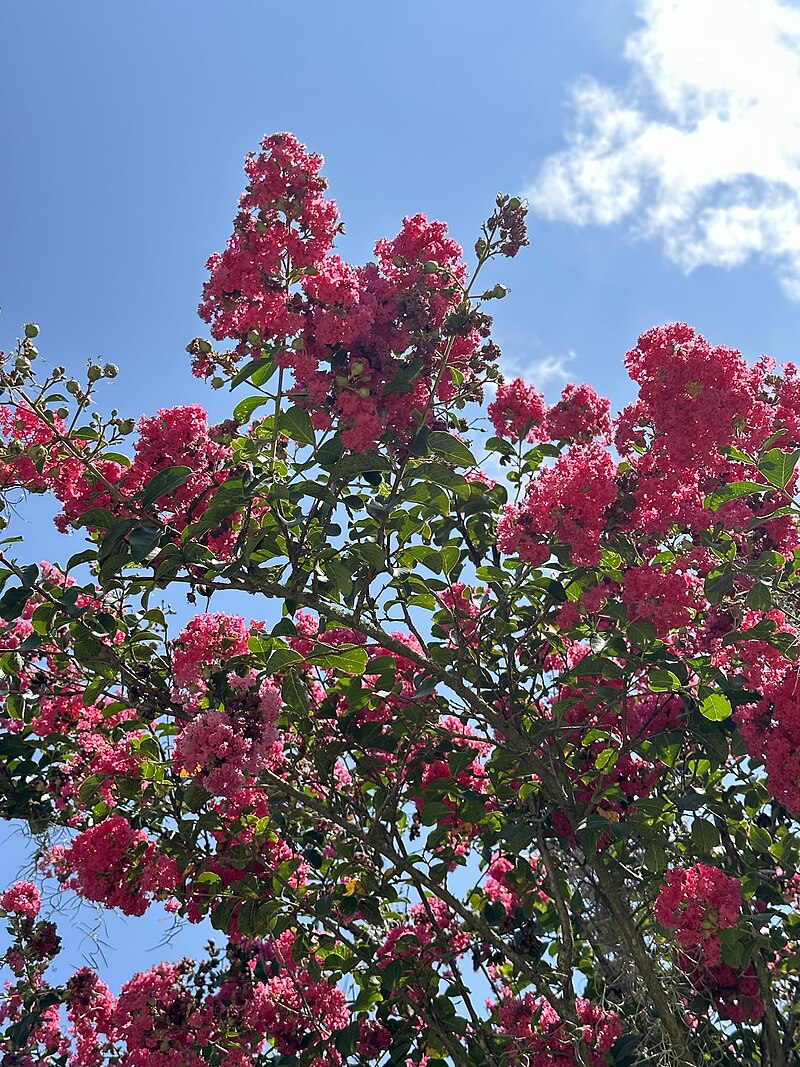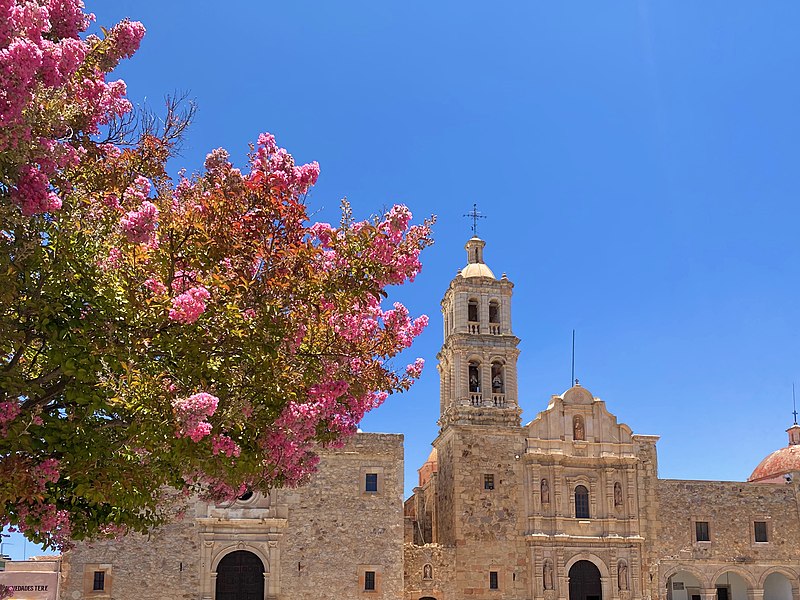Crape myrtle, with its lively blooms and hardy nature, is a beloved fixture in Texan landscapes. Known scientifically as Lagerstroemia indica, it was honored as Texas’s state shrub in 1997. You’ll appreciate its adaptability and colorful display, making it a favorite among gardeners and landscapers. One of its standout features is the flowering period, which can last up to 120 days. During this time, crape myrtles burst with colors like white, pink, red, and lavender, creating a stunning visual in any garden.
Another notable aspect of crape myrtles is their bark characteristics. As the plant matures, the bark undergoes an exfoliating process, revealing a beautiful palette of brown and gray shades. This unique trait adds an extra layer of ornamental interest, even when the plant isn’t in bloom. During fall, the leaves shift into brilliant shades of orange and red, further enhancing its aesthetic appeal.
Historical Roots in Texas
In 1857, the lively crape myrtle made its Texan debut thanks to the efforts of General Sam Bell Maxey’s wife, who introduced this ornamental shrub to the state. Its expedition began in earnest after the 1916 fire in Paris, Texas, when the community welcomed the crape myrtle as part of their beautification efforts. This act not only restored the town’s aesthetic appeal but also cemented the shrub’s place in local tradition and cultural significance.
The resilience of communities in Texas, similar to the establishment of early settlements like San Antonio, showcases a spirit of renewal and growth in the face of adversity, as evidenced by Texas’s rich history. Fast forward to the Texas centennial celebration, A.G. Pat Mayse played a crucial role by selling crape myrtle seedlings, further embedding its importance in Texan identity. This shrub’s influence is evident in three key developments:
- Tourist Attraction: The picturesque display of crape myrtles along highways between Paris and the Texas-Oklahoma border draws visitors, enhancing regional pride.
- Legislative Recognition: Formal resolutions have acknowledged the crape myrtle’s role in Texas culture.
- Community Symbol: The shrub is celebrated as a symbol of community identity and heritage, reflecting its deep historical roots in Texas.
Community Engagement Efforts
Community engagement plays a vital role in the flourishing presence of crape myrtles across Texas. You’ll find that cities like Waxahachie have demonstrated remarkable initiative, planting over 2,000 crape myrtles through the efforts of the Crape Myrtle Council.
Volunteer initiatives are significant in this effort. By joining forces with neighbors and local organizations, you actively contribute to planting and maintaining crape myrtles. This collective effort fosters a sense of ownership and pride in your local landscape, making it a more lively place to live. Programs like Brazos Beautiful, Inc. also play a vital role in promoting environmental health by encouraging the urban planting of crape myrtles.
When you visit places like Richard Carter Park, you’ll witness over 20 varieties of crape myrtle. Such collections highlight the diversity and beauty these shrubs bring, reinforcing community pride. In cities like Paris and Waxahachie, designated as Crape Myrtle capitals, you can truly see the impact of strong civic cooperation and identity.

Essential Planting Tips
Here’s how to make sure your crape myrtles thrive:
- Soil Requirements: Choose a location with well-drained soil. If your garden soil is heavy clay or overly compacted, consider amending it with organic matter to improve drainage. This helps prevent root rot and encourages strong root development.
- Sunlight Needs: Plant your crape myrtles in a spot that receives full sun exposure—at least six hours of direct sunlight daily. Full sun not only boosts flowering but also reduces the likelihood of diseases that can thrive in shaded conditions.
- Fertilization: Apply a slow-release fertilizer, such as 19-5-9, in early spring. This provides necessary nutrients for healthy growth and lively blooms throughout the season.
Growth and Maintenance Guide
Once your crape myrtles are properly planted, ensuring they thrive requires a thoughtful approach to growth and maintenance. Start by understanding that while crape myrtles are relatively low maintenance, some attention is needed during the initial two years as they are established. Regular pruning is essential. Employ proper pruning techniques to encourage lively blooms and maintain plant health. Focus on removing faded fruit capsules; this simple task can trigger further blooms within 30-45 days.
In terms of placement, make sure your crape myrtles are in full sun. Shadier locations may reduce flowering and increase the risk of disease, so ideal sun exposure is key in disease management. If space is a concern, consider planting dwarf or semi-dwarf cultivars, which range from 3 to 15 feet tall, offering flexibility without compromising on beauty.

Landscape Design Applications
When considering landscape design applications, crape myrtles offer a flexible and lively improvement to any garden. Their long-lasting summer blooms create a striking specimen or group them together for a colorful focal point. By underplanting with contrasting ground covers, you can boost visual interest and depth, crafting intricate color combinations that captivate throughout the seasons.
Here are three ways to incorporate crape myrtles into your landscape design:
- Small Spaces: Due to their adaptability, crape myrtles are perfect for tight spots near sidewalks or parking lots. They optimize limited areas while delivering aesthetic appeal.
- Outdoor Living Areas: Use crape myrtles to provide shade for decks and patios, improving the comfort and usability of these outdoor spaces.
- Formal and Informal Settings: Their versatility allows crape myrtles to fit seamlessly into different designs, from structured formal gardens to relaxed, informal settings, contributing to overall beautification.
Embrace the adaptable nature of crape myrtles and investigate the endless possibilities they bring to your landscape. This will ensure a garden that’s both functional and stunning year-round.
Varieties of Crape Myrtles to Consider
There’s a crape myrtle for nearly every landscaping need. Here are a few popular options:
1. Natchez
- A large tree with white flowers and striking cinnamon-colored bark.
2. Muskogee
- Medium-sized, with lavender blooms and excellent disease resistance.
3. Tonto
- A smaller variety featuring deep pink flowers and ideal for compact spaces.
4. Dwarf Varieties
- Perfect for container gardening or edging, with options like the petite Petite Plum or Chica Red.
Wrapping Up
Crape myrtles are more than just plants. They’re a cornerstone of Texas landscaping, offering a blend of beauty, function, and ease of care. Their vibrant blooms, adaptability, and year-round interest make them a go-to choice for anyone looking to enhance their outdoor spaces.


